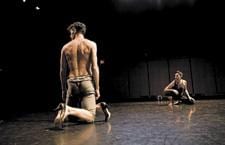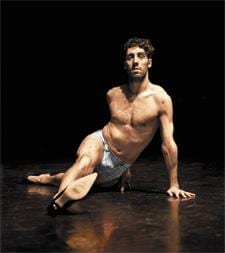
'If I wear my high heels but I am clearly a man, there's this message that people immediately have,' says Inthamoussú (left), co-creator of EXpose. He likes to play with the heels in unexpected ways. Credit: Joshua McVeity

Intertwined with ascribed and accepted notions of gender is how we experience and respond to beauty, which for gays, plays a significant role in acceptance, says Tolentino(right), who partnered with Inthamoussú to create EXpose. Credit: Joshua McVeity
Martin Inthamoussú knows it’s not easy to find size 10 high heels.
“When I went to buy those shoes it was at a very chic place in Montevideo,” he recalls. “[The storekeeper] said, ‘We don’t have your size here, but we do have it behind’ — you know, where they keep the old stuff they are not selling.
“They had so many shoes in size 10 and 11. Nobody was buying it, so I got it for half price.”
The heels are a central motif in EXpose, the contemporary dance vehicle through which Inthamoussú and fellow choreographer Alvin Erasga Tolentino explore sexuality and gendered experience in gay culture.
At the beginning Inthamoussú strips to his underwear, slips on the heels and staggers across the stage before dropping his underwear. “If I wear my high heels but I am clearly a man, there’s this message that people immediately have; there’s this one direction people go,” the Uruguayan dancer observes.
The question is how can you play with that received message — play with the heels in unexpected ways, he offers. “I’m not going to put on my shoes and walk like a lady.”
The scene challenges assumptions about gender roles. “Who made a decision in society that we can’t wear high heels?” Tolentino asks. “Were there any rules? Who made the rules?”
Intertwined with ascribed and accepted notions of gender is how we experience and respond to beauty, which for gays, plays a significant role in acceptance, Tolentino posits. “We aspire to [be] someone who is beautiful, don’t we?” he says. “To have a beautiful face and beautiful dress. This is something for me, as a gay person, to aspire to — the notion of the female archetype.”
For Tolentino, Audrey Hepburn, Marilyn Monroe and Bette Davis are symbolic of a period that represents what iconic beauty is. The three come alive through the dancers’ bodies, their voices and a multimedia presentation.
But Tolentino is not content to portray what he calls the “superficial idea of, ‘Oh, they are so beautiful’ and the glamour around it.
“I think for the gay community that’s the pathetic side of it; that’s the decadent side of it.
“We don’t just project the pictures in the piece and that’s it,” he elaborates. “We really work on what it means with our bodies. We don’t want to stay on the surface of the icon.”
Inthamoussú contrasts the three women with three more contemporary gay icons — Lady Gaga, Madonna and Britney Spears. The latter trio are gay products, he says, while Hepburn, Monroe and Davis were not professionally catering to the gay community. “I guess that’s why these [latter] icons are better for us because they are in more of a pure moment.”
Ultimately, Inthamoussú says, EXpose is the creation of two gay people talking about issues that resonate with gays, using dance and its platform to present the realities of being gay in different parts of the world. Tolentino points out that he is Asian living in Canada and Inthamoussú is a South American living in Europe.
But Inthamoussú feels there really are no major differences — in some ways. Take homophobia, he says. “When I go to Germany I hear people say, ‘Everything is fine and we can get married,’ and then you see they have the same problems as someone living in South America,” he points out.
“They say, ‘I can walk hand in hand with my boyfriend in the street,’ and then you see how people insult them in the train. They say, ‘This is not happening,’ but it really is happening.’”
If anything, the experience of homophobia has heightened, Tolentino adds. His aim is to respond to that experience through dance — what he describes as “a pathway to challenge the audience” through art.
“I’m not a filmmaker where I can work through the documentation of a certain individual, through their upheavals and all that.”
Tolentino says contemporary dance allows him to present a dynamic story, rich with emotional complexity and the memory of intensely personal issues, where the rigidity of rules has no place. “Martin and I have the capacity to play [with qualities] we want to embody and express when we’re dancing, and those might come around certain experiences that we’ve gone through over the years, being a gay youth or being gay young adults,” Tolentino explains.
What those memories are and how they manifest trigger ideas for their physical expression. “That’s the beauty of it for me as a dancer,” he says. “You can write about it, but with dance you can embody it.”

 Why you can trust Xtra
Why you can trust Xtra


